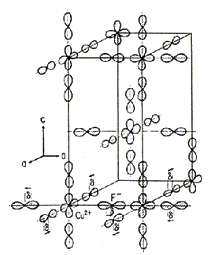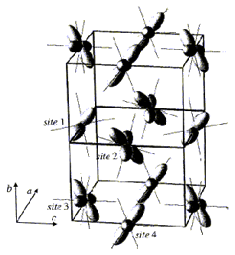 |
||||||||||
How to Observe the Orbital Ordering
In order to observe the orbital ordering, we adopt polarized neutron diffraction method. This method determine orbital ordered state from observed magnetic form factor. The first application was performed by Akimitsu and Itoh in 1976. We observe orbital ordered state in various materials, using the polarized neutron diffraction method. We succeeded in determining orbital state in K2CuF4, YTiO3, Lu2V2O7.


2.1 Neutron Diffraction Method
Neutron is perticle with zero chage, ![]() of nuclear spin. So it has 2 values on spin angular momentum;
of nuclear spin. So it has 2 values on spin angular momentum; ![]() . Neutron is scatted by nucleus of an atom and magnetic moment of an electron, so called nuclear scattering and magnetic scattering. As the interaction between the neutron and nucleus causes the nuclear scattering, it is observed in any atom. As the interaction between the neutron spin and magnetic moment causes magnetic scattering, it is observed only in magnetic atoms. As a result, neutron scattering can get information about crystal, magnetic structure and shape of orbital etc. In order to observe the orbital ordering, it is neccesary to observe the magnetic scattering in detail. This is why we adopt the polarized neutron diffraction technique.
. Neutron is scatted by nucleus of an atom and magnetic moment of an electron, so called nuclear scattering and magnetic scattering. As the interaction between the neutron and nucleus causes the nuclear scattering, it is observed in any atom. As the interaction between the neutron spin and magnetic moment causes magnetic scattering, it is observed only in magnetic atoms. As a result, neutron scattering can get information about crystal, magnetic structure and shape of orbital etc. In order to observe the orbital ordering, it is neccesary to observe the magnetic scattering in detail. This is why we adopt the polarized neutron diffraction technique.
2.2 Polarized Neutron Diffraction Method
Magnetic scattering intensity depends on the neutron spin direction. Therefore we observe the intensity with controlling the spin direction. Neutron generated in nuclear reactors is unpolarized. So we change the neutron spin in the same direction, using polarizer. Then we compare the intensity of up spin neutron: I+ and that of down spin neutron: I- with controlling the spin direction using spin flipper.@
 ,
, ![]()
As we observe ratio between I+ and I-: R, we can determine magnetic structure factor FM in detail. (If we know the crystal structure, nuclear structure factor: FN is calculated.) Scattering cross section is corrected by the resolution of spectrometer and the shape of sample. But in case of polarized neutron diffraction experiment, these factors are offset by division of numerator and denominator.